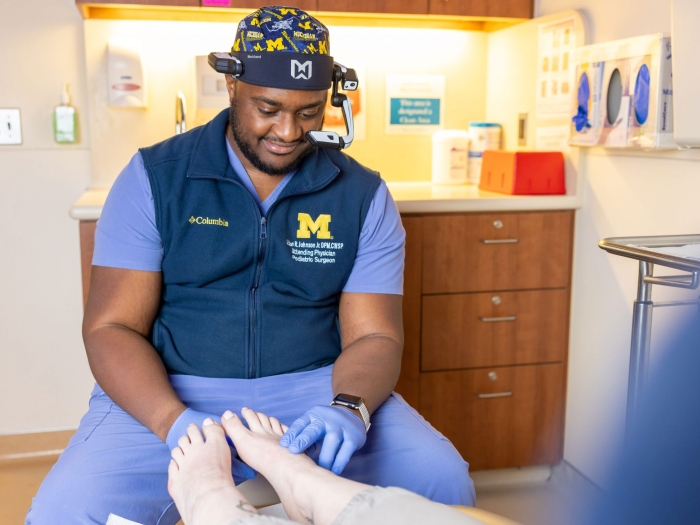BlueLink’s features increase access to human anatomy educational materials
5:00 AM
Authors |

In 2014, Glenn Fox, Ph.D., and B. Kathleen Alsup, Ph.D., were relatively new faculty members in the division of anatomical sciences at the University of Michigan Medical School.
And in their roles, both knew they wanted to incorporate high quality multimedia materials into their curriculum, free from the restraints of copyright laws.
Fox, who serves as the director of the institution’s anatomical donations program and is also a lecturer, and Alsup, the director of anatomical sciences at the U-M Medical School, were at the early stages of developing what is now known as BlueLink, a multimedia-based educational resource that focuses on human anatomy.
The tool, which is free to use, includes photography, videography and virtual reality learning resources from anatomical donors, along with comprehensive lab manuals and interactive files with click-to-reveal testing capabilities.
It’s also available to anyone at Michigan Medicine who uses human anatomy for teaching, learning, research and/or interacting with patients.
SEE ALSO: How One Virtual Program Changed the Anatomical Sciences
“Our goal was to provide individuals with the material that we wanted as students,” said Fox.
“We also wanted to provide ourselves and our colleagues with the material we sought as educators, and then share these resources with the rest of the world.”
Fox and Alsup’s initial idea involved attaching barcodes to physical anatomical specimens that when scanned by students in the lab, would open instructional videos featuring faculty members walking through the major features of each specimen. But the barcodes wouldn’t scan due to an application error, and with no formal training in videography, the content had low production value.
Yet the team still believed in their vision.
To salvage their idea, the pair decided to move away from scanning physical specimens within the lab and instead, create an original human anatomical atlas comprised of photographs, or a detailed map of the human body featuring images that could be accessible to users online.
To create this atlas, they performed their own dissection on an anatomical donor while taking photographs.
These images later became the basis for BlueLink.
Our goal was to provide individuals with the material that we wanted as students. And we wanted to provide ourselves and our colleagues with the material we sought as educators, and then share these resources with the rest of the world.” Glenn Fox, Ph.D.
Today, the pair is focusing on expanding their resources available through BlueLink by using eXtended Reality, which is an umbrella term that includes VR, augmented reality and mixed reality.
This was inspired by acknowledging that not all students are scheduled for all lab dissections. And according to Fox, these new resources offer a highly realistic alternative when in-person learning isn’t an option, like during the COVID-19 pandemic.
The team secured funding from the CRLT Whittaker Fund and Fox applied to the RISE Innovation Development Program at U-M Medical School to develop these XR resources.
Now, as an Innovator in this 12-month program, Fox receives support through monthly workshops, individual meetings with the RISE core team and leadership coaching that will help support the ongoing development of BlueLink.
“I really appreciate the monthly sessions the most because the focus isn’t on me. The focus is on the process,” Fox said.
“It’s nice to see the bigger picture and to understand that the pathway of innovation is something that you can be very intentional about. You can support that innovation, its development, and its implementation and assessment, for example, through several different practices.”
Fox added that he also appreciates being able to receive and reflect on feedback he receives through RISE, which is helping him chart a path forward.
“I think that in the absence of RISE, you might have an individual who hits a wall, who doesn’t know where to go next, who doesn’t know what type of expertise they can leverage or if that expertise even exists in our organization,” he said.
“But RISE helps you connect the dots and make those connections.”
BlueLink’s reach
BlueLink is primarily used by first-year medical students with additional usage from first-year dental students, residents and anyone who wishes to study anatomy at Michigan Medicine.
Globally, the BlueLink website received 270,000 users over the last year, primarily from within the United States, but reaching as far away as South Africa and the Philippines.
Fox notes that while many useful anatomy tools and applications exist, BlueLink is unique because its resources are free for educational and non-commercial use, making it a novel innovation within the field.
“Being of service, being useful to another person is something that is essential to my own feelings of happiness and satisfaction. One of the great things about working at Michigan Medicine is that I may work in the service of others,” he said.
“We recognize that we’re extremely privileged in having a donations program and access to these donors, and that many places do not have these things. Being able to create resources for our students and then share them with the world is a wonderful solution for programs where they don’t have anatomical donors. We’re really proud to be a part of this.”
To stay informed about RISE opportunities and education innovation happening at Michigan Medicine, join its community

Explore a variety of health care news & stories by visiting the Health Lab home page for more articles.

Department of Communication at Michigan Medicine
Want top health & research news weekly? Sign up for Health Lab’s newsletters today!





